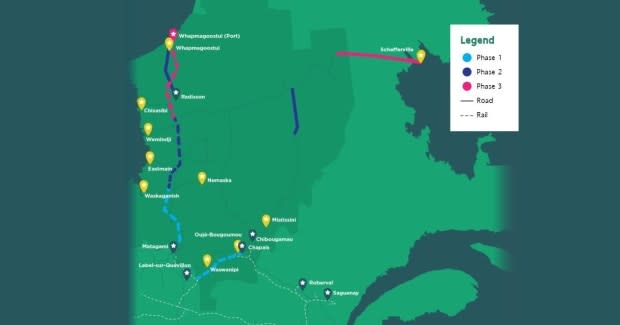$4.7B 'Grande Alliance' agreement in northern Quebec is called Cree vision of development
The Cree Nation Government says a $4.7 billion economic development project signed Monday with the province of Quebec is the Cree vision of development and represents a "clear break from the past colonial and paternalistic government policies" that kept their communities underdeveloped.
The Grande Alliance project includes a road, a railway and a deep sea port for the most northern Cree community of Whapmagoostui, located on the shore of Hudson Bay, currently accessible only by air.
The deal also includes 700 kilometres of new railway between the non-Indigenous Abitibi community of Matagami and Whapmagoostui, as well as hundreds of kilometres of new and upgraded roads and new power lines, according to Cree Grand Chief Abel Bosum.
"We are here today not to make a sacrifice or surrender. Today is not part of some concession or a difficult compromise. We are not forced to be here as part of a settlement," said Bosum, adding the deal will be implemented over 30 years in three phases.
"The vision came from us, the Cree of Eeyou Istchee," he said, using the name the Cree have for their traditional territory.
Bosum and Quebec Premier François Legault signed a memorandum of understanding Monday, and will collaborate over the next 12 months to carry out a multimillion-dollar feasibility study, jointly funded by the Cree, Quebec and possibly the federal government. The plan also includes the electrification of some industrial projects and training of the local labour force.
Protected areas identified

"The project will help to unlock the wealth of the region's varied natural resources and create jobs and business opportunities," said Quebec Premier François Legault. He also said it is a balanced approach to development with an eye to protecting the environment.
The deal lays out plans to protect large parts of Cree territory, which have been identified as environmentally and culturally important to the Cree. In 2018, the Cree Nation identified 30 per cent of its territory that it would like to see protected.
"The thing that's really unique [in the Grande Alliance] is the fact that the priority of the Cree Nation to protect is incorporated in Quebec's desire to develop," said Cree Deputy Grand Chief Mandy Gull, who is responsible for the protected areas file for the Cree Nation Government.
The project is the result of more than a year of discussions between the Cree Nation Government and the Cree community chiefs, and more recently with the Quebec government. Most of the Cree chiefs were on hand for Monday's announcement.

"It's going to provide opportunities for our people in terms of jobs," said Wemindji Chief Christina Gilpin, who also said it's important for community chiefs to get ready for some of the potential negative social impacts of development.
Gilpin also added that one of her main concerns is that the railway not interfere with the protected areas located near her community, which is located some 14 hundred kilometres north of Montreal on James Bay.
Chief Bosum said the project will help get minerals to international markets, in particular lithium and vanadium, which are present in northern Quebec and are key minerals in the transition to renewable forms of energy.
Chief Bosum said the ambitious infrastructure improvements that are part of the deal will make Eeyou Istchee more attractive to development, but adds that the project will also give the Cree more control over what kind of development they want.
"Where you put the infrastructure is where the mines usually are easier to develop," said Bosum, adding the Cree hope to own part of the infrastructure to be built.
"Right now, we're always reacting to development …. I'd rather be in control as opposed having someone else develop their plan in my backyard."
'It's not a pipeline'
Bertie Wapachee, head of a local business development group in Chisasibi, the largest of the Cree communities with a population of more than 5,000, and the former head of the Cree Health Board, said his main concern is about the impact the development will have on the land.
"When we're talking about a railroad going north, you know for a fact that everything we do in development there's always two sides. One is the positive impacts the spin offs," said Wapachee. "My first concern is always the environment."
Wapachee said he does see the positives to expanding the railway network and recognises that it will have much less impact than what First Nations are facing in British Columbia.
"It's not a pipeline," said Wapachee.

For both Grand Chief Bosum and Premier Legault, the Grande Alliance represents a different approach to development.
"We can use what we see today as a model for other nations," Legault said, adding that Quebec and Cree have built up a relationship of trust since the signing of the James Bay and Northern Quebec Agreement in 1975.
"What's key is really to speak to each other and have confidence and develop together for the benefit of both parties," Legault said.
Protests called inevitable outcome
A disruption in rail service caused by anti-pipeline protesters is moving into its second week, including a shutdown of rail service across Eastern Canada. Protestors are against attempts to move forward construction of 670 kilometre natural gas pipeline that would cut across northern B.C., including the traditional Wet'suwet'en territories.
Chief Bosum said the protests and railway shutdowns happening across the country are the inevitable outcome of the old way of doing things.
"That's what happens when you don't listen to people or when you try to go ahead and develop a project without their consent," said Bosum.
"That's a lesson to learn and hopefully that you know the governments across Canada will understand that there is a better way of approaching First Nations and vice versa. Now the objective is to work together."


